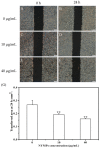Evaluating Antitumor and Antioxidant Activities of Yellow Monascus Pigments from Monascus ruber Fermentation
- PMID: 30544614
- PMCID: PMC6321613
- DOI: 10.3390/molecules23123242
Evaluating Antitumor and Antioxidant Activities of Yellow Monascus Pigments from Monascus ruber Fermentation
Abstract
Yellow Monascus pigments can be of two kinds: Natural and reduced, in which natural yellow Monascus pigments (NYMPs) attract widespread attention for their bioactivities. In this study, the antioxidative and antibreast cancer effects of the water-soluble NYMPs fermented by Monascus ruber CGMCC 10910 were evaluated. Results showed that water-soluble NYMPs had a significantly improved antioxidative activities compared to the reduced yellow Monascus pigments (RYMPs) that were chemically derived from orange or red Monascus pigments. Furthermore, NYMPs exhibited a concentration-dependent inhibition activity on MCF-7 cell growth (p < 0.001). After a 48-h incubation, a 26.52% inhibition yield was determined with 32 μg/mL of NYMPs. NYMPs also significantly inhibited the migration and invasion of MCF-7 cells. Mechanisms of the activities were associated with a down-regulation of the expression of matrix metalloproteinases and vascular endothelial growth factor. Rather than being alternatively used as natural colorants or antioxidants, this work suggested that NYMPs could be selected as potential functional additives in further test of breast cancer prevention and adjuvant therapy.
Keywords: MCF-7 cells; antioxidation; invasion; migration; natural yellow Monascus pigments; water-soluble.
Conflict of interest statement
The authors declared no conflict of interest.
Figures






References
MeSH terms
Substances
Grants and funding
LinkOut - more resources
Full Text Sources
Other Literature Sources
Medical

